Last October I involved you in a project at at Ss. Trinità dei Pellegrini, the FSSP parish and my adoptive home parish in Rome. Historically, the place had never been a parish church. Therefore, it didn’t have a baptistry or font. Now that they are a parish, they needed a font for baptisms. They had a fundraiser which I – and you – got involved in, and we quickly raised the money they needed.
I had an update on the baptismal font. Here’s a photo. The font is “on the way”!
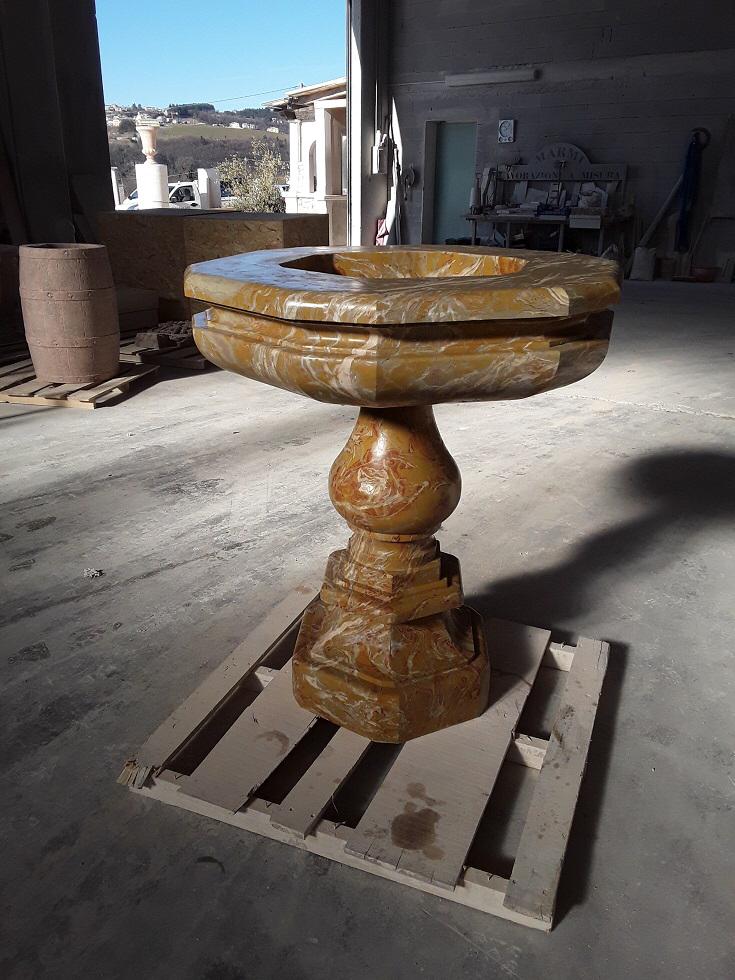
Thanks to all of you who stepped up last October.
Meanwhile, my old friend, the mighty Archbishop of Portland, Most Rev. Alexander Sample, is in Rome for his ad limina visit. He celebrated Holy Mass for the Feast of the Purification on Sunday at Ss. Trinità … or as the Romans might say Tirnità.
Here are some shots from their page.
Some comments along the way. First, note the folded chasubles on the deacon and subdeacon.
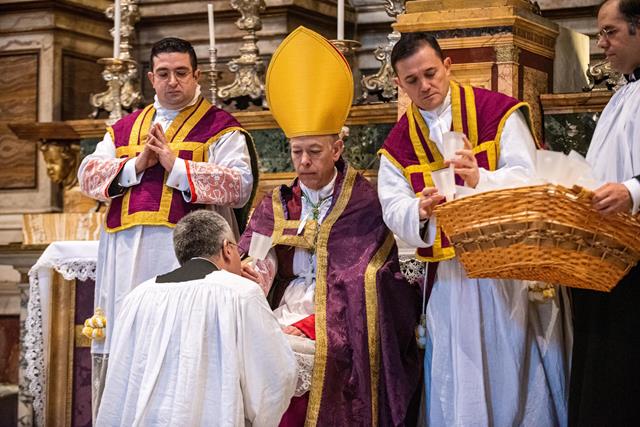
In the traditional distribution of candles, you kiss the candle and the priest’s hand as you receive it. It is, therefore, a liturgical act, far more than, “Here. Have a candle.”
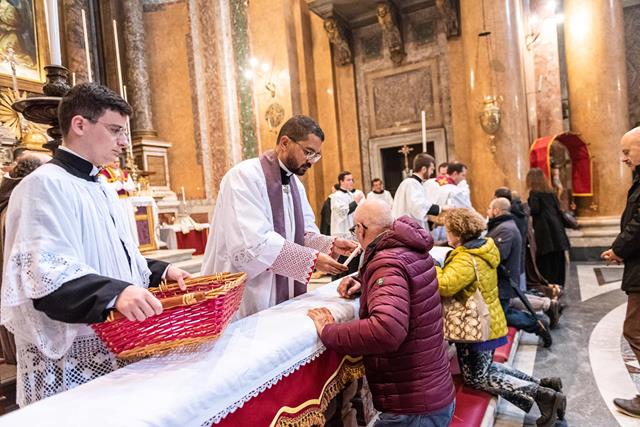
Ready for the procession. Note that Bambino Gesù is in the house. The Feast of the Purification is the last hurrah of the Advent/Christmas/Epiphany cycle. This is the last time we sing Alma Redemptoris Mater, for example.
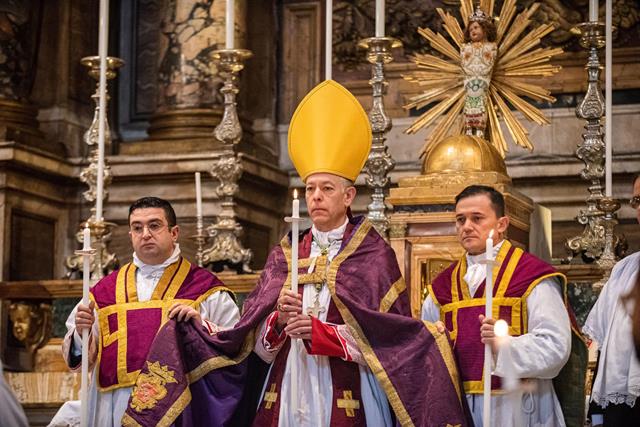
At Ss. Trinità dei Pellegrini they have, with the help of The Great Roman™, revived the ancient Archconfraternity set up by the Co-patron of Rome, St. Philip Neri. Their original mission was to minister to pilgrims to Rome. Today they are also working to promote a more zealous practice of the Faith through liturgy, processions and devotions.
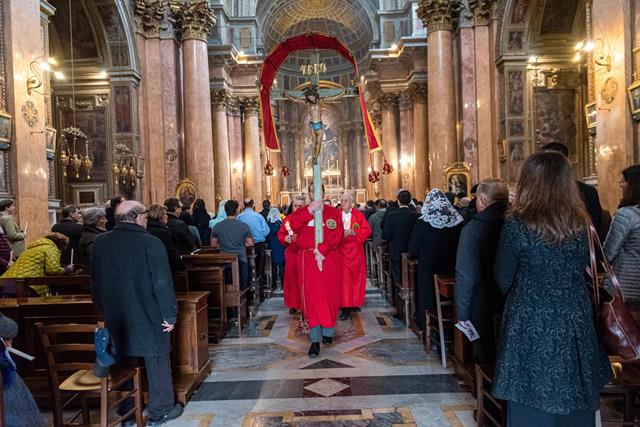
Out into the streets.
“Meno chiacchiera! Più processioni!”
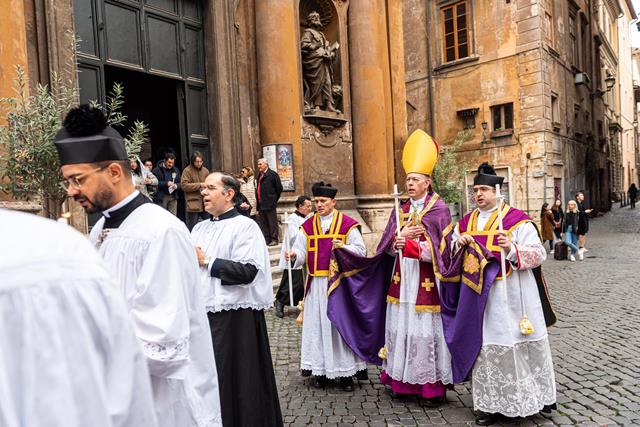
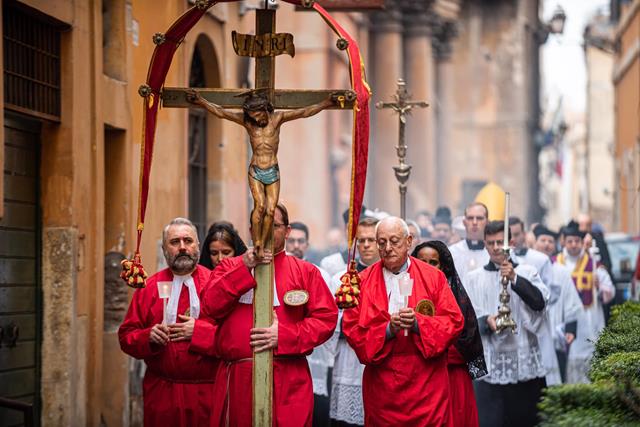
Back in the church, it’s time for Mass. The ministers and altar change to white. The blessing of candles and procession take the place of the prayers at the foot of the altar. After reverencing the altar, they go straight up for the incensation.
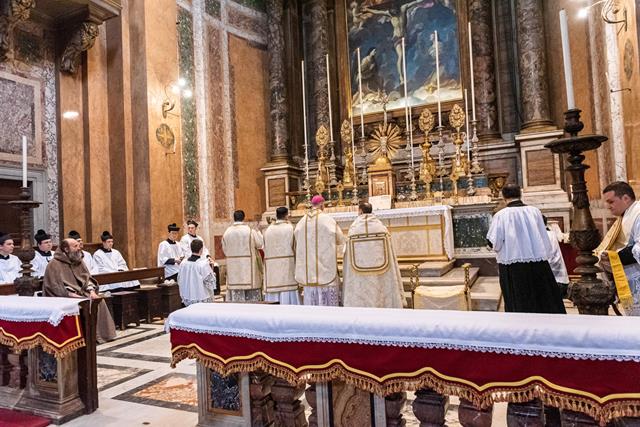
How a celebrating bishop ought to dress and to sit. It is also an old custom for the ministers to sit with their right foot slightly ahead of the other, in the old Roman manner of ancient holder of imperium seated in his curule chair.
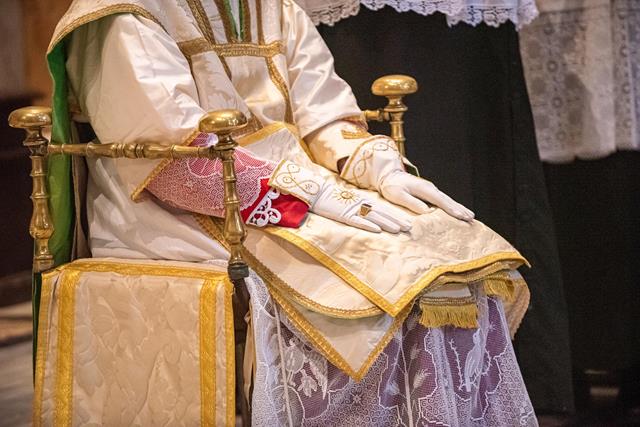
As usual the church was full.
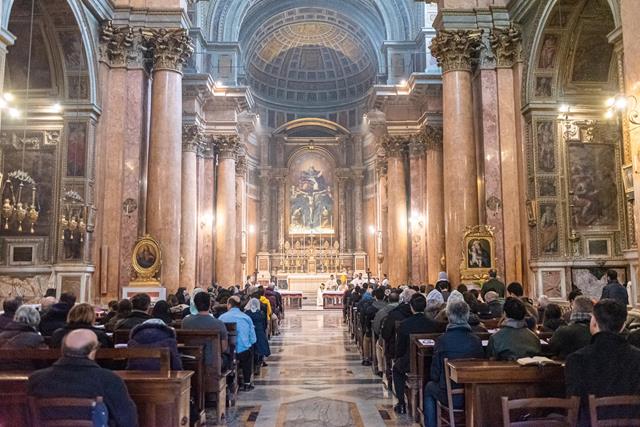
They used a pax brede. This gadget is used to carry the kiss of peace from the altar to those in choir.
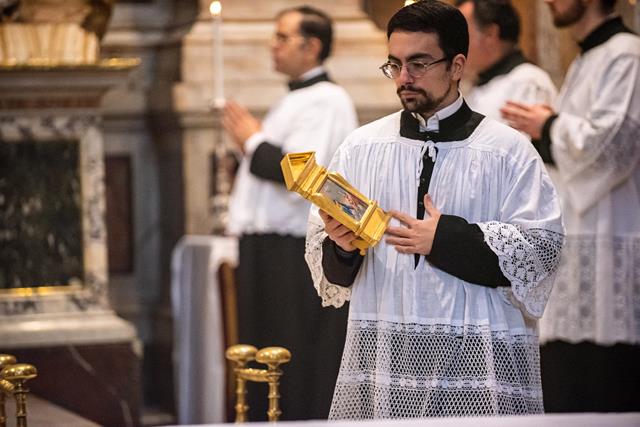
A truly Roman Mass has a lot going on.
I am please to see these photos of the font and of Archbp. Sample and the crew at Ss. Trinità.

































In our parish we were instructed to kiss the candle and then the priest’s hand.
Father, why do they start with the violet vestments?
Are those folded chasubles from a ’54 or a ’62 rubric? A discrepancy between hand missals that we observed on Sunday has me wondering whether there was a change to the distribution of candles in the 1962 M.R.
I wish I were at this Mass. sadly I have been in Israel for the past 2 months where there is hardly a Latin Mass. There is a mass in the Dominican Rite on Sundays in Jerusalem at the chapel of the Austrian Hospice. But in Tel Aviv, nothing. I loved reading these posts and looking at the photos. For me the Latin mass is heaven on earth. Time and space are suspended. I hope to go to a Latin Mass in Florence on Ash Wednesday.
Thanks for the update on the font! I will be there May 3rd and was hoping to see it installed in its new home.
Our priest (FSSP) wore white through it all.
Back here in Archbishop Sample’s own diocese, we had a special Latin Extraordinary Form Candlemas event at Sacred Heart in Medford, Oregon, complete with twelve servers, kissing/blessing candles for all, and a procession. Our very special first-year priest Father Stephen Kenyon did the honors. It was a wonderful occasion. Plus, hearty potluck food and his catechesis afterwards in the hall. He is totally dedicated to this and only 29 years old. Every since December 1 we have had a weekly Latin Mass in Southern Oregon. All thanks to Archbishop Sample, indeed.
I’ll attempt to answer two questions above, with a little fun snark included
1. Violet vestments for the Procession. Unfortunately, by the time of the 1962 Missal, the happy-clappy attitudes of the Modernists was already in play. The 1o62 Missal changed the vestments color for the Canlemas procession was changed from violet to white. Bugnini the Innovator was in his ascendance. He had already snowed Pius XII. Before that time, Procession were always considered penetential. So violet, not Easter white.
2. Folded chasuables. Same. Dalmatics were for moments that were for the triumph of the Resurrection. Folded chasuables were penetential moments. I’m glad to see their return.
Before the Council, Anabale Bugnini had little influence over the course of events. That he was “secretary” did not in itself put him “in charge” of anything, never mind any ability to “snow” a pope who had much greater and more established minds to command his attention. This is clear to those who read recent biography by Yves Chiron (refer to page 41), or the memoirs of Cardinal Antonelli (the first six chapters). [Sorry. I don’t buy this.]
This is important, not because it changes the merits (or lack thereof) of any changes, but because it better enables one to focus on what really transpired to bring about these changes (which almost no one does, at least not objectively).
After all, the effort to #UniteTheClans doesn’t get any easier when Holy Week comes around. [And yet, we must not shy from difficult, necessary, challenges.]
Beautiful photos. Wonderful that Archbishop Sample is furthering the true mass everywhere he goes.
@FranzJosef:
I was curious myself about the violet vestments for the procession (vs. white for the Mass) in those photos, so I checked my 1962 missal. Sure enough, it specifies violet for the blessing of candles and procession, white for the Mass–just as the photos show. So–I don’t see any Bugnini-ordered changes in the 1962 missal as far as the vestment colors for Candlemas are concerned. Do you have any evidence to the contrary? [It could be that that isn’t really a 1962 Missale Romanum. By 1962 white was proscribed for both. In many places now, however, the former practice is being used as more consistent with the tradition of the Roman Rite.]
But I’m generally curious as to why purple vestments would be worn at all during the celebration of a joyous Christmastide feast, especially since this year it took place before Septuagesima Sunday (Feb. 9 this year). Do any commenters know why or how this tradition came into being?
[Before joyful feasts, we adopt a penitential spirit in preparation. Vigils of feasts and liturgical seasons before the greatest feasts (Christmas/Epiphany and Easter), are draped in violet. Even before the Mass of Candlemas, there is a violet draped moment of preparation, also with a procession, which usually have strongly penitential overtones, such as in the cases of processions for Roman Station Masses. Processions generally included the singing of the Kyrie and litanies. Ordinary and Extraordinary Processions. Ordinary are those within the calendar, such as Candlemas, Palm Sunday, Rogation Days, etc. Extraordinary, such as emergencies to avert disaster or in thanksgiving for relief, the translation of relics, etc.]
”Sorry. I don’t buy this.”
Many people wouldn’t unless they read the books, including accounts of those who were there.
”And yet, we must not shy from difficult, necessary, challenges.”
I quite agree, but surely there is a right way and a wrong way.
[Some of us have read the books.]
@Fr. Z:
Just checked my missal. It’s a reprint from the Angelus Press. The title page calls it “The Roman Catholic Daily Missal, 1962.” Below that it says: “With Kyriale in Gregorian Notation, Compiled from the Missale Romanum.” [It seems they got it wrong.]
On. p. 1104 is the Mass proper for Candlemas. There is a notation of “white” for white vestments. Nonetheless, the first section of that proper, titled “The Blessing of the Candles and the Procession,” specifies: “The Priest, vested in a violet cope, blesses the candles, which are placed near the altar.” There is no specific direction for the priest to change into white vestments for the Mass, but it seems to be assumed that he will do so. [No. In 1962 the whole thing is in white, blessing of candles, procession, etc. Really.]
This has made me wonder if the use of white vestments for the procession really did precede the 1962 Missale Romanum. So I consulted an older missal in my possession: a “Marian Missal” popular during the 1950s that is only partially bilingual (Latin with English translations for the sung parts of the Mass, English only for the readings). The edition I have has an imprimatur of 1958. It incorporates Pius XII’s (Bugnini-inspired) 1956 alterations to the Holy Week liturgy. But for the liturgy of Candlemas, it specifies a violet cope for the blessing of candles and the procession but white vestments for the Mass. Since Pius XII died in 1958, Bugnini could not have influenced him to eliminate the violet–which, as I’ve pointed out, survives in my 1962 missal (which I have no reason to think isn’t based on the Missale Romanum of 1962).
So, I’m wondering if the switch to white vestments for the procession wasn’t one of those pre-Vatican II innovations of progressive priests (like having lay people bring up the bread and wine for the Offertory) that got later incorporated into the Novus Ordo. It might have been one of Bugnini’s ideas, but as far as I can tell it never got incorporated into the rubrics, at least until after the Council.
Your explanation of the procession as a mini-penitential makes sense. It’s interesting, though, that by 1962 the vigil of Epiphany did not call for violet vestments, although Christmas Eve did. Christmas Eve also used to be a day of abstinence, so Christmas Eve dinner was a “feast of fish.” My mother always made chowder or cioppino.
[Open in new tab for larger. This is a 1962 Missale Romanum.]
It may be worth highlighting that there were so many changes led by Annibale Bugnini (under three popes) that even missals published in 1962 would soon become obsolete with newer versions published in the same year (the insertion of Saint Joseph in the canon, for instance, was in November 1962). Bugnini’s constant tinkering was precisely what Benedict (Ratzinger) was criticizing when he wrote about mid-20th century liturgical reforms as a “banal, on-the-spot product.”
On the questions of violet versus white vestments during the blessing of candles and procession on 2 February, and the use of folded chasubles, the changes (eliminating violet on 2/2 and folded chasubles) are to be found in the 1960 rubrics. Specifically #120(b) and #137. https://maternalheart.org/library/1962rubrics.pdf
As mentioned previously, the FSSP in Rome (and elsewhere) has received permission for use of some pre-1962 rubrics — exemplified in the Candlemas photos.
@Fr. Z
@Kenneth Wolfe:
Well, I can’t fight that photo (“albo”)!
How fascinating that my version of the 1962 missal is actually behind the 1962 times, so to speak. St. Joseph is in the Canon in my version–but nonetheless someone forgot to change that violet to white. It was hard to keep up with Annibale Bugnini.
Father,
good to see the font.
I doubt that after reverencing the altar they went straight up to the altar to cense it. After all, they used the pre-1955 form for the procession. In the pre-55 form there are prayers at the foot of the altar at Candlemas.
I am aware of the indult available for celebrating the pre-1955 Holy Week. I was not aware of any indult for celebrating pre-’62 Candlemas. Where can I learn more about this?
Charlotte Allen: “but nonetheless someone forgot to change that violet to white.”
I’d say that’s the reason. They may not have checked a hand missal too closely, whereas (I think?) what Fr. Z shows is an Altar missal, which would have been accurate. My mother received a gift of a beautiful daily missal in 1968, printed in 1967, with the latest version of the actual Mass as it then was, but within the “daily” parts they just reprinted the earlier texts, rubrics etc. e.g. the Epistles and Gospels are all Douay-Reims, which we weren’t using at that stage, it being a more modern version, probably the 1966 RSV, Catholic edition. I remember both parents regretting that. I’d love to have the RSV for the lectionary now, if not the D-R.
“In the traditional distribution of candles, you kiss the candle and the priest’s hand as you receive it. It is, therefore, a liturgical act, far more than, “Here. Have a candle.””
Indeed, and magnificent photos. From the Ignatius Press description of Fr. Lang’s “Signs of the Holy One: Liturgy, Ritual, and Expression of the Sacred“:
Catholic liturgy is far more than its texts. It is a synthesis that also includes several other elements— gesture, music, art, and architecture— which are aspects of the non-verbal language of the sacred and are what make the liturgy beautiful.